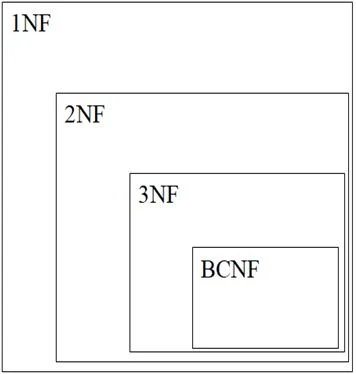Normalization in DBMS
Normalization is a process that “improves” a database design by generating relations that are of higher normal forms.
The objective of normalization: “to create relations where every dependency is on the key, the whole key, and nothing but the key”.
We discuss four normal forms: first, second, third, and Boyce-Codd normal forms
1NF, 2NF, 3NF, and BCNF
There is a sequence to normal forms:
1NF is considered the weakest,
2NF is stronger than 1NF,
3NF is stronger than 2NF, and
BCNF is considered the strongest
Also,
any relation that is in BCNF, is in 3NF;
any relation in 3NF is in 2NF; and
any relation in 2NF is in 1NF.
a relation in BCNF, is also in 3NF
a relation in 3NF is also in 2NF
a relation in 2NF is also in 1NF
We consider a relation in BCNF to be fully normalized.
The benefit of higher normal forms is that update semantics for the affected data are simplified.
This means that applications required to maintain the database are simpler.
A design that has a lower normal form than another design has more redundancy. Uncontrolled redundancy can lead to data integrity problems.
First we introduce the concept of functional dependency
Functional Dependencies
We say an attribute, B, has a functional dependency on another attribute, A, if for any two records, which have
the same value for A, then the values for B in these two records must be the same. We illustrate this as:
A à B
Example: Suppose we keep track of employee email addresses, and we only track one email address for each employee. Suppose each employee is identified by their unique employee number. We say there is a functional dependency of email address on employee number:
employee number à email address
If EmpNum is the PK then the FDs:
EmpNum à EmpEmail
EmpNum à EmpFname
EmpNum à EmpLname
must exist.
EmpNum à EmpEmail
EmpNum à EmpLname


First Normal Form
We say a relation is in 1NF if all values stored in the relation are single-valued and atomic.
1NF places restrictions on the structure of relations. Values must be simple.
The following in not in 1NF
EmpNum
|
Empphone
|
EmpDegrees
|
123
|
250-7853
| |
233
|
250-1325
|
BA,BSC,PhD
|
976
|
250-2311
|
BSc,MSc
|
EmpDegrees is a multi-valued field:
employee 976has two degrees: BSc and MSc
employee 233 has three degrees: BA, BSc, PhD
EmpNum
|
EmpPhone
|
EmpDegrees
|
123
|
250-7853
| |
233
|
250-1325
|
BA,BSC,PhD
|
976
|
250-2311
|
BSc,MSc
|
To obtain 1NF relations we must, without loss of information, replace the above with two relations are given below
Boyce-Codd Normal Form
BCNF is defined very simply:
a relation is in BCNF if it is in 1NF and if every determinant is a candidate key.
If our database will be used for OLTP (on line transaction processing), then BCNF is our target. Usually, we meet this objective. However, we might denormalize (3NF, 2NF, or 1NF) for performance reasons.
Second Normal Form
A relation is in 2NF if it is in 1NF, and every non-key attribute is fully dependent on each candidate key. (That is, we don’t have any partial functional dependency.)
• 2NF (and 3NF) both involve the concepts of key and non-key attributes.
• A key attribute is any attribute that is part of a key; any attribute that is not a key attribute,
is a non-key attribute.
• Relations that are not in BCNF have data redundancies
• A relation in 2NF will not have any partial dependencies
Consider this InvLine table (in 1NF):
InvNum
|
LineNum
|
ProdNum
|
Qty
|
InvDate
|
There are two
candidate keys.
Qty is the only non-key attribute, and it is dependent
on InvNum
|
Since there is a determinant that is not a candidate key, InvLine is not BCNF
InvLine is not 2NF since there is a partial dependency of InvDate on InvNum
InvLine
InvNum
|
LineNum
|
ProdNum
|
Qty
|
InvDate
|
The above relation has redundancies: the invoice date is repeated on each invoice line.
We can improve the database by decomposing the relation into two relations:
Third Normal Form
• A relation is in 3NF if the relation is in 1NF and all determinants of non-key attributes are candidate keys That is, for any functional dependency: X ® Y, where Y is a non-key attribute (or a set of non-key attributes), X is a candidate key.
• This definition of 3NF differs from BCNF only in the specification of non-key attributes - 3NF is weaker than BCNF. (BCNF requires all determinants to be candidate keys.)
• A relation in 3NF will not have any transitive dependencies of non-key attribute on a candidate key through another non-key attribute.
Consider this Employee relation
EmpName, DeptNum, and DeptName are non-key attributes.
DeptNum determines DeptName, a non-key attribute, and DeptNum is not a candidate key.
Is the relation in 3NF? … no
Is the relation in 2NF? … yes
Is the relation in BCNF? … no
We correct the situation by decomposing the original relation into two 3NF relations. Note the decomposition is lossless.
Verify these two relations are in 3NF.








Comments
Post a Comment
please subscribe my blog and let me suggest how I improve this site